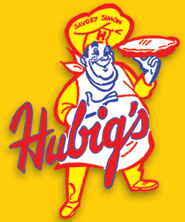Red beans and rice are the traditionally served food in New Orleans on Monday's. This was the beginning of the work week, and when the wash was usually done. They put on a pot of
red beans and rice, and knew that when they came back there would be that delicious pot, flavored by the ham bone from Sunday's dinner awaiting them.
The recipe in the above link looks pretty good and gives you the bones of the dish. While last in New Orleans I made my first pot of red beans, which came out well I must say. I always incorporate various renditions, then add a little of my own additions. The brand famous in New Orleans is Camellia Brand.
The recipe that I have found to be the most interesting is from the
gumbo pages which have a great selection of recipes:
The quintessential New Orleans dish, traditionally served on Mondays.
A lot of this is going to be trial-and-error, and it's going to take a little practice before you get it right. Me, I got good at it by making it once a week for over two years, and putting out an open invitation to my friends that there'd be red beans 'n rice at Chuck's place every Sunday (well, it was tough to cook on Mondays back then).
This dish holds a very special place in my heart. While I have many favorite dishes, and have had fabulous meals the likes of which come along very rarely ... this is tops. It's delicious, it's cheap, it's simple, and it makes me feel good. It's the number one comfort food in the world for me.
You'll probably want to fiddle with it each time you make it, and arrive at the exact, instinctual combinations of seasonings that you like. Feel free to alter this recipe to your taste, but don't stray too far.
You can make this dish completely vegetarian, and it's still really good; instructions are below.
This recipe is featured on pages 116-117 of the 2001 Frommer's Guide to New Orleans, for which I also wrote a bunch of restaurant reviews. Neato!
- 1 pound red kidney beans, dry
- 1 large onion, chopped
- 1 bell pepper, chopped
- 5 ribs celery, chopped
- As much garlic as you like, minced (I like lots, 5 or 6 cloves)
- 1 large smoked ham hock, 3/4 pound of Creole-style pickle meat (pickled pork), or 3/4 lb. smoked ham, diced, for seasoning
- 1 to 1-1/2 pounds mild or hot smoked sausage or andouille, sliced on the bias
- 1/2 to 1 tsp. dried thyme leaves, crushed
- 1 or 2 bay leaves
- As many dashes Crystal hot sauce or Tabasco as you like, to taste
- A few dashes Worcestershire sauce
- Creole seasoning blend, to taste; OR,
- red pepper and black pepper to taste
- Salt to taste
- Fresh Creole hot sausage or chaurice, links or patties, grilled or pan-fried, one link or patty per person (optional)
- Pickled onions (optional)
It's not necessary to soak the beans overnight, but you can if you want to. If you do, drain the water and cover the beans with a double volume of fresh water in the pot. (This helps reduce the, um, flatulence factor.) Bring the beans to a rolling boil. Make sure the beans are always covered by water, or they will discolor and get hard. Boil the beans for about an hour, until the beans are tender but not falling apart.
While the beans are boiling, sauté the Trinity (onions, celery, bell pepper) until the onions turn translucent. Add the garlic and saute for 2 more minutes, stirring occasionally. After the beans are boiled and drained, add the sautéed vegetables to the beans, then add the ham hock (or ham or pickle meat), smoked sausage, seasonings, and just enough water to cover.
Bring to a boil, then reduce heat to a low simmer. Cook for 2 hours at least, preferably 3, until the whole thing gets nice and creamy. Adjust seasonings as you go along. Stir occasionally, making sure that it doesn't burn and/or stick to the bottom of the pot. (If the beans are old -- say, older than six months to a year -- they won't get creamy. Make sure the beans are reasonably fresh. If it's still not getting creamy, take 1 or 2 cups of beans out and mash them, then return them to the pot and stir.)
If you can ... let the beans cool, stick them in the fridge, and reheat and serve for dinner the next day. They'll taste a LOT better. When you do this, you'll need to add a little water to get them to the right consistency.
Serve generous ladles-ful over hot white long-grain rice, with good French bread and good beer. I also love to serve grilled or broiled fresh Creole hot sausage or chaurice on the side. Do not serve with a canned-beet salad, like my Mom always used to do. (Sorry, Mom ... try something interesting with fresh beets and we'll talk. :^)
I like serving a few small pickled onions with my red beans -- I chop them up and mix them in with the beans. It's great! Why does it taste so good? As my sister's friend (and dyed-in-the-wool New Orleanian) Cherie Valenti would say ... "It's da vineguh!"
YIELD: 8 servings
I used this and then improvised: adding some dried orange peel, some sherry vinegar, a dash of pomegranate molasses, and a TBS of brown sugar or the piloncilla they have in Mexican grocery stores.
This dish is very similar to Feijoada, a Portuguese dish very popular in Brazil and Columbia. Here is another Feijoada recipe.
So enjoy!
Big Chief Howie








